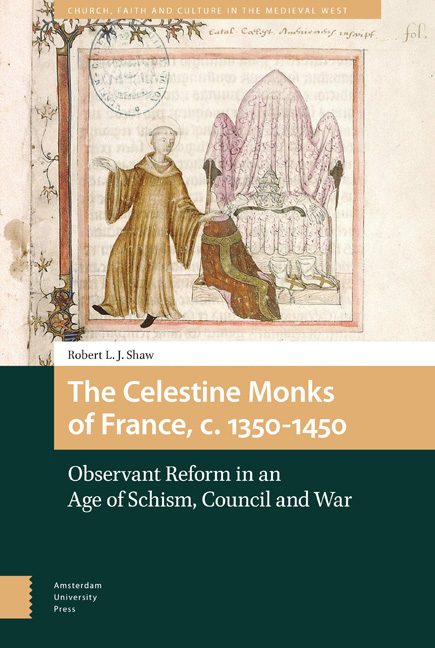Book contents
- Frontmatter
- Contents
- Maps and Figures
- Abbreviations
- Acknowledgements
- Introduction: The Celestine monks of France and the rise of ‘Observant’ reform
- Part I The French Celestines in their world
- Part II The world of the French Celestines
- Epilogue and conclusion
- Appendix 1 Lists and map
- Appendix 2 Reductions of foundation Masses (beyond anniversary Masses) at the Celestine monastery of Paris, 1414 and 1436
- Appendix 3 Reduction of foundation Masses (beyond anniversary masses) at the Celestine monastery of Sens, 1414
- Index
Introduction: The Celestine monks of France and the rise of ‘Observant’ reform
Published online by Cambridge University Press: 16 February 2021
- Frontmatter
- Contents
- Maps and Figures
- Abbreviations
- Acknowledgements
- Introduction: The Celestine monks of France and the rise of ‘Observant’ reform
- Part I The French Celestines in their world
- Part II The world of the French Celestines
- Epilogue and conclusion
- Appendix 1 Lists and map
- Appendix 2 Reductions of foundation Masses (beyond anniversary Masses) at the Celestine monastery of Paris, 1414 and 1436
- Appendix 3 Reduction of foundation Masses (beyond anniversary masses) at the Celestine monastery of Sens, 1414
- Index
Summary
The history of the Celestine monks of France – or to give them their full, contemporary title ‘the Celestine brothers of the province of France and adjacent regions’ – in the late Middle Ages has until recently lain buried. It is the history of a congregation that no longer exists, a self-governing province of an Italian Benedictine reform of thirteenth-century origin that likewise no longer exists, and which has received very little subsequent attention. Compared to many other monastic reforms, the volume of work on the French Celestines is slight; in fact, the Celestines as a whole remain one of the least studied medieval monastic congregations. Only one modern monograph has focused on them, Karl Borchardt's Die Cölestiner, an excellent study of the order's entire institutional history, which covers their presence in Italy as well as France. Beyond this, there is a body of work on their early Italian foundations, while a small number of doctoral theses and articles have devoted some attention to their French wing.
This lack of attention, however, is a grave injustice on every level. The history that will emerge in the course of this book is of a congregation that reached a significant apex of cultural impact and influence around the turn of the fifteenth century, on a scale disproportionate to its relatively small, albeit growing, size in this period. Theirs was a journey which has much to tell the modern reader about the ideals and practice of late medieval monastic reform; they represent one of the most prominent groups in France to label themselves as ‘Observant’ in this period, a banner for a wave of reform efforts across multiple orders of which the importance is only now coming to be fully understood. But they also represent a powerful example of the potential that still lay within the ties that bound monasticism and wider society together. It is the history not only of a monastic congregation but of those bonds that this book sets out to uncover.
The Celestines and the French Celestines
Who were these somewhat forgotten monks? The Celestines had their origins in Italy. They were founded by a hermit, Pietro da Morrone, later canonized as St Peter Celestine (c.1215–1296), who, according to his earliest biographers, had first lived as a Benedictine monk at Santa-Maria di Faifoli in the Molise region before becoming a solitary in the caves of the Abruzzo mountains.
- Type
- Chapter
- Information
- The Celestine Monks of France, c. 1350–1450Observant Reform in an Age of Schism, Council and War, pp. 13 - 32Publisher: Amsterdam University PressPrint publication year: 2018

